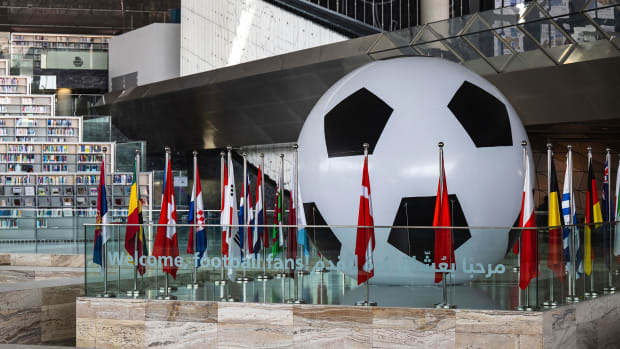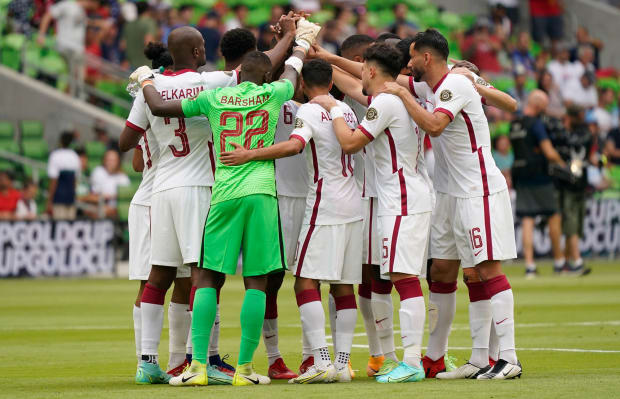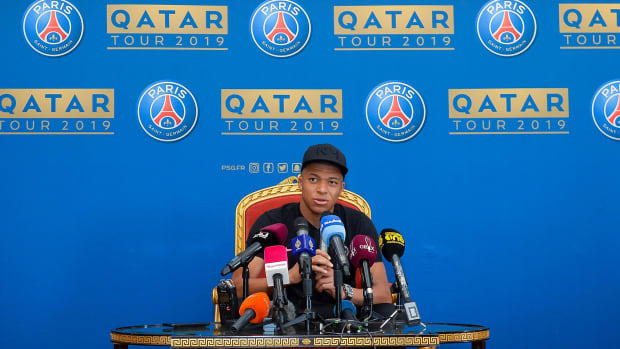AL RAYYAN, Qatar – The building that explains this nation’s soccer history is surrounded by college campuses and shaped like a diamond, the immense space inside like an airplane hangar, only modern and open and yet somehow still crammed with over a million books. For now, though, the centerpiece display at the Qatar National Library in Education City isn’t Arab-Islamic science texts written in Latin in 1448, nor some of the first Arabic books ever printed.
No, as with all things in the region this month and next, the World Cup is the prominent display. And here, on the library’s ground floor, there is an exhibit that explains Qatar’s soccer ambitions, along with its small but growing place in the modern international game, along with what that means for all their other aspirations, politics included.
Factoids abound near a soccer ball that resembles a tiny house, the one guarded by flags from all the participants in this tournament. One of the first-ever officiated matches here took place in Dukhan, in 1948, “under the supervision,” naturally, “of a petroleum company.” Soon after, the first Qatari football team, the Arab Union, formed, its roster fashioned from workers the petroleum company employed. By ’51, Qatar had created its first football championship.
GOAAAL!, as it’s titled, features black-and-white photos, and an old, oversized, brown leather ball that was long ago deemed useless, hand-stitched Maroons national team jerseys and retro boots. The exhibit details how “football” became central to schools here; how outsiders in a country that’s comprised of roughly 90% non-natives brought in experience and training techniques; notes on the first international match (1970), first World Cup qualifying match (‘77), first “taste of international success” (the ’92 Gulf Cup victory) and the most significant tournament victory to date (the Asian Cup final triumph, over Japan, in 2019).

Andrej Isakovic/AFP/Getty Images
Some of the literature is, shall we say, penned with creative license. Like the bit about the country’s status as one of only three in the world to host an annual day just for sports. Or the part that inflates its credentials for holding international tournaments, of which there have been some. That’s Qatar, though. True and perhaps true never stray far from each other.
True: Pelé and his Santos side did play here (1973). Maybe true? Pelé earned his first-ever yellow card in that match.
True: magazine and newspaper articles are displayed as part of the exhibit. Maybe true: the regime values, as it says, the journalists that cover soccer. If so, perhaps that’s because it tells them what to write.
Said to be true: “Qatar is looking forward, and more excited and enthusiastic than ever, to welcome guests from all over the world for an exceptional World Cup.” That’s a quote attributed to Sheikh Tamim bin Hamad Al Thani, referred to as His Highness. But after 10 days on the ground here, it’s safe to say that government officials are not looking forward, nor are all that enthusiastic. The tournament, at least so far, has a long climb toward exceptional.
Even then the overall billing of the exhibit – for certain fans of the game, it is still an untold story – holds. This is that story.
Maybe the tenor above isn’t exactly fair. It’s certainly not how Qataris themselves view their soccer evolution. One in particular, a historian who candidly shared his feelings in exchange for anonymity, believes that context, nuance and credit are too-often missing from the narrative.
The historian notes that when Qatar established its own clubs, those clubs became markers of national identity, a point of pride. The historian’s father would tell stories of watching Pelé play in person, against an Egyptian side; he even skipped school to attend.
“Moments like these, that mean a lot to this region, have been erased,” he said at a coffee shop last week. “It’s all just, you know, this crazy, mega-wealthy oil state buys itself a World Cup.” The historian allows that, of course, this sentiment is part of the story. But he says that journalists leave out the corresponding passion, from thousands who don’t make the laws, who cannot control how the stadiums are built. It’s minimizing to them, the historian contends. “They’ve been written out of the story.”
Rolling now, the historian notes that something like 90% of the estimated $220 billion spent on hosting the first World Cup in the Arab World was funneled toward projects that had merely tangential relationships to soccer, like buildings, highways, roads, the metro, railways, housing – all the infrastructure necessary. That price tag was more than the country’s annual GDP. Some of those billions went toward education, cultural projects, museums. Those factors, he says, can help change other factors, like labor laws and human rights abuses. Not to mention how Qataris define themselves, as more than a place where oil is drilled, extracted and sold for staggering profits. The historian sees Qatar becoming a cultural hub that happens to include sports.
Do you believe him?
That’s not the historian’s concern. He cares more about what this country will be, what it could be, than what it is. He sees the Proud Maroons as emblematic of Qatar and how it’s changing, from the roster stocked with players from here, Africa, Europe and Iraq to the team that competes all over the world, including at the Asian Cup, the Arabian Gulf Cup and last year’s Concacaf Gold Cup, where Qatar made the semifinals and scored a tournament-high 12 times. The team is helmed by Félix Sánchez, a Barcelona protégé who coached at the well-respected Aspire Academy in Doha, before taking over as Maroons manager. Most of his players trained at Aspire; all play in the Qatari league, then train more at Aspire, momentum building, fast.

Scott Wachter/USA TODAY Sports
This is how a World Cup team is built in a tiny country where soccer didn’t exist until 1948.
Still, many disdain Qatar’s decisions to naturalize team members. Its World Cup roster features four players who required naturalization (among other dual nationals, which is a more standard aspect of the international game), while migrant workers suffer inhumane indignities with zero prospects of becoming citizens.
It’s class. It’s privilege. It’s international in scope, ambitious. It’s marginalized groups building soccer kingdoms. It’s certain communities—LGBTQ, poor, outsiders—being unwelcome at those same places. It’s one way of life—and the antithesis of that same existence.
It’s football. And it’s Qatar. And all of that is typically met with the same reaction here.
A shrug.
In Qatar, an independent nation-state designed as essentially an absolutist monarchy, gas led to wealth and wealth birthed ambition. The world’s largest gas field, in fact, was arguably the first factor that tipped the country toward the World Cup, when it was discovered way back in 1971. The coffers it filled allowed the country’s rulers to begin to envision Qatar not as a blip on maps adjacent to powerful neighbors but as a blip on maps that deserved to move into the same neighborhood of vast geopolitical influence and opulence.
His Highness—and those family members who preceded him—even believed he knew the vehicle to make that happen. Sports. And, within a booming athletics industry, no sport mattered more than soccer.
Proof is in what was once Doha’s tallest building, which stands above so many other jack-and-the-giant-beanstalk towers. The Aspire Tower looms almost 1,000 feet above the concrete, perpetually-under-construction sprawl outside downtown. Constructed for the Asian Games in 2006, built by (who else?) migrant workers, it’s less of a tower and more of a maze devoted to soccer. There are stadiums, best-in-class technology, treatment facilities, world-class doctors, elite trainers, coaches from all over the world, gyms and residences that resemble the five-star hotels nearby.
The investment didn’t end there. Qatar bought into or simply bought European soccer clubs, like Paris Saint-Germain, and created television networks and development programs. To counter very real threats from quite powerful neighbors—Saudi Arabia to the east, Iraq and Iran to the north—Qatar courted equally powerful allies, including America, a country for which His Highness built a billion-dollar air base, which remains the Pentagon’s Central Command here. It has proven critical for forays into Iraq, Afghanistan and Syria. Diplomats from Qatar have been credited with setting up the talks that led to America’s departure from Afghanistan.

Xinhua/Imago Images
Qatar also built its own international media network, the beIN Media Group. BeIN, according to its website, has more than 55 million paid subscribers, more than 30 million social media followers across myriad platforms and covers, through its athletics arm, more than 20 sports. Its broadcasts land on 60 channels in five continents, beaming into homes in 43 countries via seven languages. One channel in Spain is devoted entirely to fútbol. But beIN also invested in disparate endeavors, like Nickelodeon Turkey, Turner Broadcasting System, BBC Studios, Warner Brothers, CBS, DreamWorks Animation, Discovery and Miramax (it now owns 51%). What does all that mean? Reach. Qatar threw billions at broadcast rights for soccer leagues all over Europe. The goal, it seemed, was visibility, through sports and through soccer, through Lionel Messi and Kylian Mbappé and Neymar and David Beckham and sponsorships of Barcelona, AS Roma, Bayern Munich and the EA Sports FIFA video game franchise.
This wasn’t sportswashing. This was elite sportswashing. Qatar wasn’t saying, celebrate us, so much as it was saying, celebrate us, because we are protected, which means we’re really not as bad as we have been made out to be. Was it kleptocracy? The cost of reputational cleansing? The only path to a World Cup? Yes. To all.
This plan, all the money and influence and criticism that paled in importance compared to all the money and influence, worked to perfection, at least in the relation to the goal. Qatar landed the World Cup—and, in 2017, weaponized the bid. After a group of power-wielding neighboring countries shut down Qatar’s access to every supply route imaginable, His Highness leaned on diplomatic friendships to shift nimbly around the blockade.
And there it was. Sports, as government officials have said repeatedly after the announcement of the bid in 2010, should be separate from politics. In theory. Except, that is, when it suited Qatar to invoke sports as a political solution.
So here it was, the World Cup opener, after everything above, a mixture of awe and spectacle, contrast and contradiction. The royal box included sheiks and kings and princes and, of course, Beckham and camels and Jung Kook and floating cartoon mascots and Morgan Freeman.
Only one problem remained: the soccer itself. Al Bayt Stadium in Al Khor was built to resemble a bedouin tent, but it was the Maroons who folded like one. Sánchez, the manager, looked despondent on the bench, his face saying what his mouth could not. Wanna get away? His players appeared overwhelmed and overmatched. The final score, 2-0, failed to capture Ecuador’s dominance, but many Qataris missed the end due to a mad rush to the exits. Some even sped over to the helipad, copters waiting.
This was exactly what Eric Hobsbawm, the late British historian, meant when he wrote about soccer tournaments like the World Cup. This was football as “a medium for inculcating national feelings.” This was a game, sure, but also a global one, a widespread one, a coffer-filling one—and the combination makes it rife for geopolitical problems solved and myths (like bridges crossed and disparate groups united) peddled. This was spelled out in the body language of the Maroons, in their bulging eyes and outstretched arms. They were b-e-f-u-d-d-l-e-d. Under pressure. Worse yet, tonight, Senegal awaits.
Meanwhile, the VIPs booked it to their helicopters and their luxury SUVs. They sped back toward their palaces and their servants.
They were headed back to the city of luxury that soccer built.







